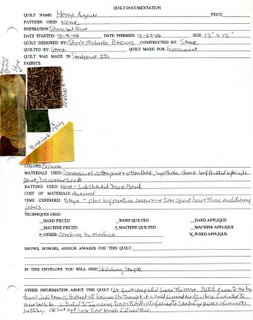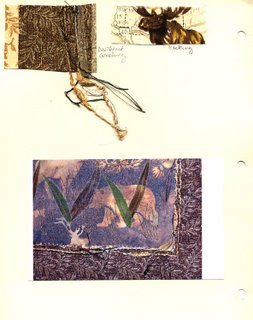The final thing culled from the week following Christmas was a reminder that goals are merely a framework, an organizational tool, something to aim for and to help one get back on track when digressing or procrastinating. What they are not are absolute. They are meant to be reviewed, adjusted, amended, added to.
The reminder came in the form of a mild rebuke. My stated goals for that week were simple: first and foremost, get the pinwheel top layered and basted for quilting. After that, update my technical journal. Yes, my mind had it that clearly set out as to what was important and what could be moved into the following week. But once I entered the studio, I noted that I had partially filled-out documentation sheets set out for two quilts, a short stack of items to be filed in other documentation folders, and a driving urge to attend to all. I caught myself doing two things - first rationalizing that working on the documentation files were similar to updating the tech journal, so it was ok to work on them, then feeling guilty that I was attending to these chores before attacking my number one goal. "Seize the moment," my rebellious self kept saying. "Get that "bookkeeping" stuff done while you have the desire." And when at the end of the week, the quilt top was mostly but not completely prepared for quilting, I knew it was because I'd deviated from my goals and worked on those files. On the other hand, I'd gotten extra things done, things that helped clear work space and would need to be done soon anyway. It was an achievement that made me feel really good, successful, exhilarated. So why was I feeling it necessary to justify having done it at the expense of my other goal? That's when I remembered that, while goals are a useful tool, I need to be careful about letting goals rule me, especially when adhering to them may actually impede my progress, or when they may no longer apply.

I thought I'd show you how I've been documenting my quilting since I got really serious about it. Someone was marketing a Manila folder with a form printed on it and holes punched along the side so that it could be stored in a notebook binder. Fill out the form with information about the quilt, attach a picture and put any pertinent materials in the envelop. I bought a set of these, then never saw them advertised again. I liked the way this filing system worked, but wanted to change some of the information included on the form, so revised the information to be included and printed my own envelops. Not every quilt needed an envelop though, so I also printed the form on index weight paper as in the picture above.
The front has the basic information such as name, date made, size, pattern or source of inspiration and other things not every quilter might want to include. For instance, I track "time spent" even breaking it down into the various components of construction, quilt prep, quilting and finishing, and also note cost of materials if I know them. I also note the kind of batting and the various techniques used. There's space to note shows & awards. The blank space is for a photo, and to the left of that I glue swatches of the fabric in the quilt. I use the back of the form or envelop for "overflow" - fabric that won't fit on the front, detail shots, additional shows or info about the quilt that won't fit in the space allowed.
 As for what goes inside the envelope - well, patterns, sketches, stitching samples, extra photos and slides, show programs, judges' critiques, copies of entry forms and rules - all helpful information to refer back to now and then.
As for what goes inside the envelope - well, patterns, sketches, stitching samples, extra photos and slides, show programs, judges' critiques, copies of entry forms and rules - all helpful information to refer back to now and then.
I originally started doing this as a record for myself, since many of my first quilting efforts were given away as gifts. Later, as I began entering exhibits and contests, having this detailed documentation made filling out forms and organizing acceptance, rejections, and award information so much easier.
Last year I noted that my form no longer fit the direction my quilting had taken and needed revising. I've added a space for selling price, and expanded the techniques category options. Now I'm noting that some information slots stay blank on many projects. Perhaps "time spent" isn't quite as important as it once was now that so many of my projects are small. And is filing the sheets in chronological order, as I've been doing for years, my best option? I sense I need a total revamp of my documentation system if I follow through with my desire to exhibit in galleries and sell my work. Perhaps that will show up on my list of goals for the year.
The reminder came in the form of a mild rebuke. My stated goals for that week were simple: first and foremost, get the pinwheel top layered and basted for quilting. After that, update my technical journal. Yes, my mind had it that clearly set out as to what was important and what could be moved into the following week. But once I entered the studio, I noted that I had partially filled-out documentation sheets set out for two quilts, a short stack of items to be filed in other documentation folders, and a driving urge to attend to all. I caught myself doing two things - first rationalizing that working on the documentation files were similar to updating the tech journal, so it was ok to work on them, then feeling guilty that I was attending to these chores before attacking my number one goal. "Seize the moment," my rebellious self kept saying. "Get that "bookkeeping" stuff done while you have the desire." And when at the end of the week, the quilt top was mostly but not completely prepared for quilting, I knew it was because I'd deviated from my goals and worked on those files. On the other hand, I'd gotten extra things done, things that helped clear work space and would need to be done soon anyway. It was an achievement that made me feel really good, successful, exhilarated. So why was I feeling it necessary to justify having done it at the expense of my other goal? That's when I remembered that, while goals are a useful tool, I need to be careful about letting goals rule me, especially when adhering to them may actually impede my progress, or when they may no longer apply.

I thought I'd show you how I've been documenting my quilting since I got really serious about it. Someone was marketing a Manila folder with a form printed on it and holes punched along the side so that it could be stored in a notebook binder. Fill out the form with information about the quilt, attach a picture and put any pertinent materials in the envelop. I bought a set of these, then never saw them advertised again. I liked the way this filing system worked, but wanted to change some of the information included on the form, so revised the information to be included and printed my own envelops. Not every quilt needed an envelop though, so I also printed the form on index weight paper as in the picture above.
The front has the basic information such as name, date made, size, pattern or source of inspiration and other things not every quilter might want to include. For instance, I track "time spent" even breaking it down into the various components of construction, quilt prep, quilting and finishing, and also note cost of materials if I know them. I also note the kind of batting and the various techniques used. There's space to note shows & awards. The blank space is for a photo, and to the left of that I glue swatches of the fabric in the quilt. I use the back of the form or envelop for "overflow" - fabric that won't fit on the front, detail shots, additional shows or info about the quilt that won't fit in the space allowed.
 As for what goes inside the envelope - well, patterns, sketches, stitching samples, extra photos and slides, show programs, judges' critiques, copies of entry forms and rules - all helpful information to refer back to now and then.
As for what goes inside the envelope - well, patterns, sketches, stitching samples, extra photos and slides, show programs, judges' critiques, copies of entry forms and rules - all helpful information to refer back to now and then.I originally started doing this as a record for myself, since many of my first quilting efforts were given away as gifts. Later, as I began entering exhibits and contests, having this detailed documentation made filling out forms and organizing acceptance, rejections, and award information so much easier.
Last year I noted that my form no longer fit the direction my quilting had taken and needed revising. I've added a space for selling price, and expanded the techniques category options. Now I'm noting that some information slots stay blank on many projects. Perhaps "time spent" isn't quite as important as it once was now that so many of my projects are small. And is filing the sheets in chronological order, as I've been doing for years, my best option? I sense I need a total revamp of my documentation system if I follow through with my desire to exhibit in galleries and sell my work. Perhaps that will show up on my list of goals for the year.
No comments:
Post a Comment